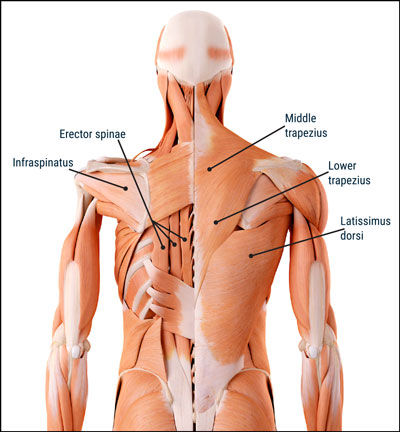
What is the Best Back Exercise?

Training the muscles of the back is complex, and for good reason. These muscles vary tremendously in terms of their functions and the angles at which they apply force on the body. This is why fitness facilities typically feature a number of machines, such as the lat pull-down and back extension machines, as well as pull-up bars and free weights, all of which can be used to train different muscles and movements.
Given the prevalence of back pain among adults worldwide, it’s not surprising that many people want to know what exercises they should be doing to help strengthen these muscles. In fact, an ACE-supported study of common back exercises published in 2018 is consistently one of our most-read articles. Clearly, there is a huge demand for quality instruction and guidance in targeting the muscles of the back. This study helped provide some answers.
The researchers focused on four muscles and one muscle group—the middle trapezius, lower trapezius, latissimus dorsi, infraspinatus and erector spinae. The idea was to evaluate muscles from the top to the lower part of the back. Here is a quick rundown of the functions of each of these muscles:
- Middle trapezius: Upward rotation and adduction of the scapulae
- Lower trapezius: Depression of the scapulae
- Latissimus dorsi: Extension, adduction, horizontal abduction and internal rotation of the shoulder
- Infraspinatus: External rotation of the shoulder (this is one of the rotator cuff muscles)
- Erector spinae: Extension and lateral flexion of the spine

Participants performed the following exercises while researchers measured their muscle activation using electromyography (EMG). Click on the study link above to learn more about each exercise.
- Lat pull-down
- Seated row
- Bent-over row
- Inverted row
- Pull-up
- Chin-up
- TRX row
- I-Y-T raise
Based in the results of this study, if a client had time to perform only one back exercise during a workout or if you are programming a group strength training class and are choosing a single back exercise, the bent-over row is the best option. This exercise activated three of the five back muscles (i.e., middle trapezius, infraspinatus and erector spinae) to the greatest degree and was the second-best option for the other two muscles (i.e., lower trapezius and latissimus dorsi).
The second-best option is the I-Y-T raise, which also effectively targeted all five muscles tested, while the chin-ups and pull-ups best targeted the latissimus dorsi.
In other words, when it comes to targeting the entire back musculature, a variety of exercises are needed. One approach for organizing a muscular-training program involves targeting pulling muscles (for example, biceps and back) on the same day. The following is a sample conditioning segment of an upper-body pulling workout that you can integrate into your clients’ muscular-training plans. This workout combines exercises from this study with a variety of exercises from the Best Biceps Exercises Study to create a fun, challenging and effective workout. Here are some instructions for your clients:
- Complete eight to 15 repetitions of each exercise in each set.
- Complete both exercises in each block (or compound set) with little or no rest between exercises.
- Perform one to four sets of both exercises in each block, depending on your client’s goals and fitness level.
- Rest for two or three minutes after every pair of exercises. For example, in block 1, the client would perform one set each of the bent-over row and concentration curls, rest for two or three minutes, then either perform additional sets of those two exercises or move on to block 2.
- The resistance should be heavy enough that the client reaches fatigue at the end of each set of eight to 15 repetitions.
- Complete this workout two or three days per week.
|
|
Exercises |
|
Block 1 |
|
|
Block 2 |
|
|
Block 3 |
|

More Articles
- Certified™: January 2023
Introducing the ACE RRAMP Approach™: A Practical Resource for Group Fitness Instructors
Contributor
- Certified™: January 2023
Make it or Break it: The Science of Habit Change
Contributor




 by
by 

